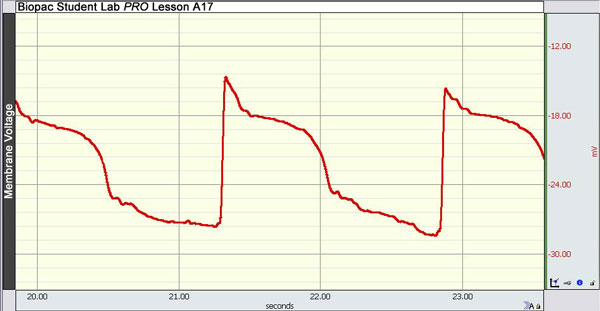A17 Frog Heart Intracellular Action Potentials

This BSL PRO lesson examines and records action potential from cardiac tissue in an amphibian. The lesson procedure and template were developed for BSL 4.0.1 or above.
Experimental Objectives
- To make an intracellular electrical recording in cardiac tissue.
- To observe and understand the electrical properties of myocardial cells in the vertebrate heart.
- To develop an understanding of the ionic basis of the electrical signals in cardiac tissue.
- To study the effects of pharmacological probes on the cardiac action potential.
Tasks Performed by the Student
- Detect the action potential signal and record cardiac potentials from several regions of an isolated heart.
- Apply Epinephrine (EPI), Acetylcholine (ACH), Nifedipine (NIF), and optionally, Na+ free or 10 mM K+ Frog Ringer’s to understand how heart function is modulated.
- Adjust the perfusion system flow control as needed.
- Position the glass electrode with the aid of a microscope and micromanipulator.
- Start and stop the recording, place event markers, monitor the data, and provide feedback.
Videos
Biopac Student Lab Student Download
Student Prep & Distance Learning
Click the link(s) below for sample data and/or lesson procedure video(s), BSL PRO Lesson procedures (PDF) for human lessons*, and graph template files (*.gtl) for BSL PRO Lessons. If more than one .gtl is available, download the .gtl with the _suffix to match BSL version and hardware.
Lesson Hardware
This lesson requires a Biopac Student Lab (BSL) System and the following hardware. If your BSL System does not include all hardware items, expand your system by selecting required items below. For more details, review the Lesson: L# BSL Lessons - see the Lab Manual or launch BSL; A# and H# BSL PRO Lessons, click the PDF link above to review full setup, recording, and analysis procedures.
| Item | Name | Cart |
|---|---|---|
| SS9LA | Input Adapter, Unisolated, BNC - MP36/35 MP46/45 | Add to Cart |
| MANIPULATOR-L | Micromanipulator, LH | Add to Cart |
| MANIPULATOR-R | Micromanipulator, RH | Add to Cart |
Stay Connected